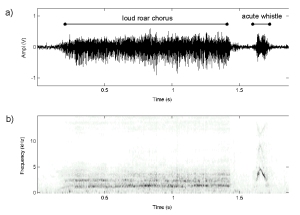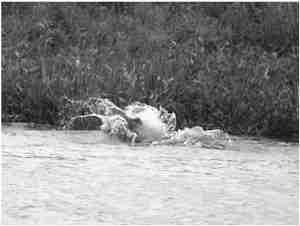 |
Last Update:
Thursday November 22, 2018
|
| [Home] |
|
Volume 21 Issue 2 Pages Pages 60 - 101 (January 2005) Citation: Ribas, C. & Mourão, G. (2004) Intraspecific Agonism between Giant Otter Groups. IUCN Otter Spec. Group Bull. 21(2): 89 - 93 Intraspecific Agonism between Giant Otter Groups Carolina Ribas1 and Guilherme Mourão2 1Dept. de Biologia- CCBS, Universidade Federal de Mato Grosso do Sul, CP 549, Campo Grande, MS 79070-900, Brazil (received 3 May 2002, accepted 5 June 2002)
Intraspecific aggression is common in mammals (EBENSPERGER, 1998), especially in carnivores for which it has been widely documented (e.g. KRUUK, 1989, McLEOD, 1990; FRANK et al.,1995). However, reports of intraspecific aggression involving otters are so rare in the literature that SIMPSON (2000) believed himself to be the first author to provide information on it. In fact, we have found only three other records of intraspecific agonistic interactions in otters (ESTES, 1989, SCHWEIZER, 1992, ROSAS and MATTOS, 2003). Giant Otters (Pteronura brasiliensis) are territorial social mammals. Groups mark their territory with the scent from their latrines and perianal glands, as well as through a variety of vocalizations. Apparently, they use these mechanisms to prevent agonistics encounters with neighboring groups (DUPLAIX, 1980; SCHWEIZER, 1992; CARTER and ROSAS, 1997). As far as we know, the occurrence of aggressive disputes between adults of different groups has been reported only once before (SCHWEIZER, 1992), and a case of infanticide has been recently published (MOURÃO and CARVALHO, 2001). Since August 2002, we have been studying the ecology and natural history of giant otters occurring in the Vermelho River region (56° 58'52" W, 19° 36' 38" S), of the Brazilian Pantanal. On one occasion, we recorded by digital video an extremely aggressive interaction between two giant otter groups at the junction of the Vermelho and Miranda rivers. In this note, we report this event and present a sonogram of the highly stereotyped vocalization displayed by the aggressor group. On the morning of 23 October 2003 at 10:15 AM, we heard a loud noise and movement of giant otters near the confluence of Vermelho and Miranda Rivers. A group of four giant otters were persecuting a single individual, which eventually escaped by leaving the Miranda river and going up the Vermelho River. The aggressor group had been studied previously, and its range comprised one stretch of about 12.1 km of the Miranda River, downstream of the mouth of the Vermelho River. At the beginning of the dispute, we observed two other individuals in peripheral positions in relation to the five active participants of the fight. We could not identify those otters or the persecuted individual based on their throat spots. However, the site of the dispute was the lower limit of the range of a group resident in the Vermelho River. That group was composed of three individuals, and it is probable that they were the animals involved in the dispute. The aggressors moved extremely fast, presenting a behavior, which we never observed before in giant otters. Instead of alternating diving and emersion, as is characteristic in the species, they swam continuously on the surface (Figure 1). The animals appeared to be "surfing" on the surface of the water for periods of about 15 seconds at a time their head, neck and forearms were exposed. While surfing at the water surface in pursuit of the otter, the aggressors produced a loud roar in a chorus interspersed with acute whistles, which we had never heard before (Figure 2). After about 60 seconds of chasing, the group managed to surround the single otter. The group stopped and first one and then two other otters attacked the surrounded animal. The remaining individual of the aggressor group did not join the fight, but stayed close and vigilant. A few moments later, the persecuted individual escaped and swam up the Miranda river.
The aggressors chased the fugitive for about 1 km. We followed the fugitive upstream for an additional stretch 1.4 km of the Miranda river. This individual had no apparent injuries. Sociability is not characteristic of the Mustelidae (JOHNSON et al., 2000). Giant otter distinguish themselves among the Lutrinae by their large body size, as well as by the size and cohesion of their social groups. Perhaps it is not a coincidence that the two other otter species for which intraspecific aggression is known, the sea otter (Enhydra lutris) (ESTES, 1989) and Eurasian otter (Lutra lutra) (SIMPSON, 2000), also present some degree of sociability (JOHNSON et al., 2000). Therefore, it is possible that intraspecific aggressiveness and sociability are associated in the Lutrinae. ACKNOWLEDGEMENTS - We thank "Pousada Rio Vermelho" for logistic support and CNPq (grant #520056/98-1) for financial support. CAPES provide a scholarship to one of us (C. R.). Isac T. Carvalho assisted us in the field. Arnaud Desbiez and William Magnusson improved the English in a draft manuscript. REFERENCES Carter, S.K. & Rosas, F.C.W. 1997. Biology and conservation of the giant otter
Pteronura brasiliensis. Mammal Review, 27, 1-26. Résumé : Agonisme intraspécifique entre des groupes de loutres géantes Resumen: |
| [Copyright © 2006 - 2050 IUCN/SSC OSG] | [Home] | [Contact Us] |


